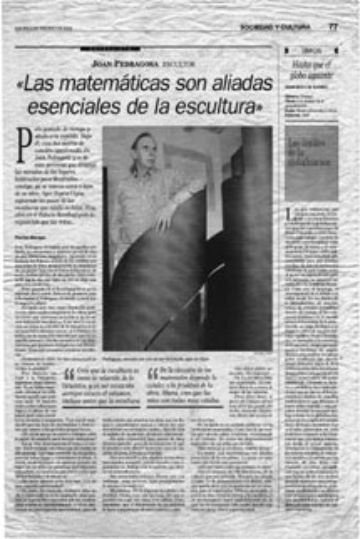

The Mathematics are allied escenciales of the sculpture
EL COMERCIO DECANO DE LA PRENSA ASTURIANA
09-08-2002
Paché Merayo
Hair faded by time and tied back. Beneath it, almost two metres of passionate Catalan. This is Joan Pedragosa, and he is one of those people who take our eyes from the usual places to carry them away with him, whether close to his work or far from it. Yesterday he arrived in Gijón, following the trail of those sculptures that he gives titles in Latin. Today the exhibition that brings them together opens in Revillagigedo Palace.
Yesterday Joan Pedragosa allowed himself to be photographed by Beta, his partner and the carnal material of one of this most unusual works. Posted at the façade of the Palace, opposite the posters announcing his work, programming a random stroll under the eighty kilos of naval steel of another of his pieces, he admitted that this encounter with Gijón was not just another tour for his sculptures.
This visit to the Revillgigedo is the second one for you. But the first time it was Pedragosa the designer that was visiting the city and not the one who is exhibiting today.
It’s true that I came as a graphic designer with four other co-workers in the field, but it is not exactly the case that there was no inclination to sculpture in me at the time. I think sculpture is like the relationship with the intuitive, and volume has always been part of my intuition. If you search your memory you’ll find that even in that first visit I was the only one of the designers that presented work in three dimensions. Those were my first little sculptures.
We’re talking about 1986. It was not so long ago that you changed course. How did it happen?
It was during a trip to Patagonia, in Argentina, that same year. I had already begun o form volumes out of what for almost everyone has its point of reference in a flat piece of paper, but those were serialised, small sculptures. After the trip I decided that it was time to go deeper and to devote myself entirely to larger sizes.
Is it true that you have never worked on paper again, even to sketch a piece?
It is. I go straight to plaster or high grammage cardboard. I make them into mock- ups, but not all of them eventually become works. At times they are turned down, set aside because I do not manage to see in them the premises that I hoped to find, they don’t evolve as I thought they should and they get stuck.
You said set aside and not rejected. Do you give them a second chance?
Yes, of course. All of a sudden, you go back to them one day, and just as everything in you has changed, they have too, and you see things that weren’t there before, new ideas in operation. Sometimes they work with a second chance, but in any case there are many ideas that never come to take shape and only a few that find their real path, letting the spirit emerge from inside them, which is the space that is really interesting.
In this exhibition there are pieces of widely differing sizes, but the impression is that it gives you more pleasure to handle one of your works of a large format and heavy weight.
There is an extra gratification in works that can compete with your own size and allow you to have a dialogue with the material that eventually leads to an understanding.
Your materials, though always metal of some kind, are nonetheless quite diverse. What role do you assign to the material?
A big one. The warmth or coldness of the work depends on it. Now, I think that my materials, the ones you can see here, are all very warm. I also think that the way you work with a material makes it behave in one way or another.
Your works beg to be touched. Do you mind?
No. Sculpture should be caressed. Physical contact is sometimes the ideal way of looking.
As an appetiser, the patio of the Palace offers a work that hangs from the ceiling, titled
Depitecus. They say it is one of his favourites. Attention has been paid to its perfect finish, its mathematical movement. Each full turn it makes corresponds to one minute. It is like the imposing second hand of a clock that never goes wrong.
Mathematics and sculpture, a good couple?
The best. Mathematics is an essential ally of sculpture. People don’t know to what point mathematics are necessary.
Why do you give your works titles in Latin?
I love the Mediterranean and the culture that came before us. I’ve always loved Latin. It gives personality to the pieces, though it should be clear that it is not an attempt at providing a message for the spectator. It is only a sound. Sometimes it is an experience prior to the sculpture or a thought, like quid futurum sit, what has to occur, which ended up being an enormous piece, now exhibited here.